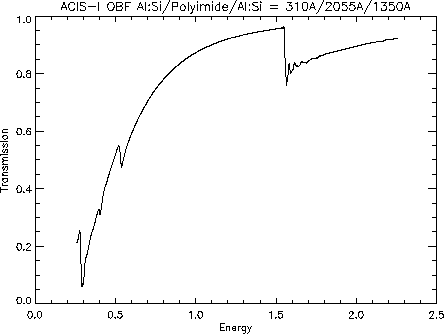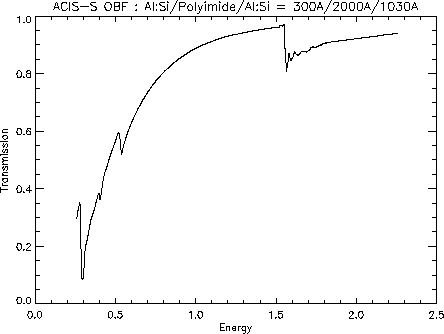
Next: 2.3.4 Door Up: 2.3 Instrument Subsystems Previous: 2.3.2.5 ACIS Flight Chip
![]()
![]()
![]()
![]()

Next: 2.3.4 Door
Up: 2.3 Instrument Subsystems
Previous: 2.3.2.5 ACIS Flight Chip
The ACIS filters are constructed without mesh supporting structures to both enhance the X-ray transmission, and to remove the absolute calibration uncertainty resulting from the mesh interfering with the PSF of the converging beam of the HRMA.
 |
 |
The free-standing filters are relatively large (roughly 2x2 inches for the I filter, 1x6 inches for the S filter). Mechanical strength and high UV opacity is provided by Polyimide, a polycarbonate plastic with a chemical composition of C22H10O4N2. On each side of the Polyimide substrate a layer of aluminum is applied to provide optical light blocking. The double coat provides electrically conducting external surfaces to prevent build-up of charges.
| Filter | Al:Si Layer 1 | Polyimide | Al:Si Layer 2 |
| I array | 310 |
2055 |
1350 |
| S array | 300 |
2000 |
1030 |
During engineering tests, it was discovered that equal aluminum thicknesses caused Fabry-Perot interference effects leading to narrow but high spectral transmission windows. Therefore, the flight filters were fabricated with unequal aluminum thicknesses on each side. The flight filter design thicknesses (as measured by Luxel, the filter manufacturer) are shown in Table 2.5.
The filter characteristics were determined by a three stage testing procedure conducted by Penn State. One suite of measurements were conducted at Penn State using Henke tube generated fluorescent X-rays and a CCDID17 CCD provided by MIT and Lincoln Lab. In this suite the filter was mounted in close proximity to the face of the CCD and measured in close approximation to flight conditions (cold temperature and CCD detectors behind them) but the length of time required and the risk of contamination prevented these measurements from being made on the finest angular scales, and limited measurement to flight prototypes only.
The need to operate the CCDs in single photon counting mode limits the brightness of the beam in the PSU measurements. To avoid this limit, synchrotron measurements were conducted; one at the Brookhaven synchrotron, and one at the Wisconsin SRC. At Brookhaven the same photo-diode detectors and beamline used by the AXAF Mission Support Team for calibrating the HXDS filters and the HRC team for calibrating the HRC detectors were used to measure the ACIS filters. Two locations on each of two non-flight filters were measured at roughly 1000 energies to carefully determine the transmission as a function of energy. Critical to these tests is the fine energy resolution, which provides the most stringent constraints on the detailed models of the transmission as a function of energy. Especially closely sampled were the filter transmissions near the K edges of aluminum, oxygen and carbon, where XAFS (X-ray Absorption Fine Structure) effects are important.
At the SRC many more spatial locations were sampled at just four energies. These measurements were made at a very large number of points on the flight filters and on the Brookhaven filters, using a small rectangular aperture (roughly 0.76 mm x 0.76 mm), and a non-imaging, non-energy-resolving photo-diode. At least two measurements were made on every AXAF dither range sized region on the filter. The high incident flux from the synchrotron allowed high precision transmission measurements to be made in only 1.5 second.
Results of SRC testing on flight filters has shown that the relative transmission across the filter, at a single energy, can be determined to within 0.1%. Measurements of the same spatial location at five different energies produced agreement with our transmission models to within an rms of 0.34%. See Section 4.2 for a more detailed description of filter test data.

John Nousek